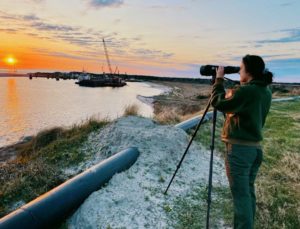Our new summer blog post series introduces you to our national parks’ Biological Science Technicians, or “BioTechs”! We are pleased to introduce you to Katie Ayers, a Seasonal Biological Science Technician at Cape Hatteras National Seashore, who answers your questions about endangered, threatened, and invasive animal and plant species at the Seashore, and how you can help protect shorebirds and sea turtles this summer and all year long. Katie Ayers, a Biological Science Technician in the Ocracoke Island district of Cape Hatteras National Seashore. Photo: Katie Ayers
How do you know which wildlife species need special protections or regular monitoring?
The wildlife species we monitor at Cape Hatteras National Seashore may be protected under one or more special regulations. Piping plovers are federally protected and listed as “Threatened” under the Endangered Species Act of 1973. American oystercatchers, black skimmers, least terns and common terns are listed by the state of North Carolina as species of “Special Concern.” North Carolina also lists the gull-billed tern as “Threatened.” All five sea turtle species (I.e., loggerhead, green, leatherback, Kemp’s ridley, hawksbill) found along Cape Hatteras National Seashore are listed under the Endangered Species Act.
These species are protected for various reasons, ranging from declining population sizes, loss of habitat from development or beach erosion, human infrastructure or disturbance, weather events, predation, pollution and entanglement in marine debris. The beaches along Cape Hatteras National Seashore are an important habitat for nesting shorebirds, waterbirds and sea turtles. Many avian species utilize the barrier islands as wintering grounds in the Atlantic Flyway migration route, too. In addition to daily monitoring, National Park Service staff work to establish Resource Protection Areas and other enclosures to ensure the survival of these species.
What can park visitors do to help protect endangered or threatened shorebirds and sea turtles?
Park visitors can help protect shorebirds, sea turtles and other wildlife on the Outer Banks through many different ways!
Enjoying the beaches at Cape Hatteras National Seashore is one of the many perks of visiting the Outer Banks! Visitors may encounter beach closures for breeding shorebirds — it is important to follow instructions posted on signs, stay aware when beach driving, keep pets on leashes and refrain from entering closures to minimize disturbances. Colonial waterbirds, such as least terns and black skimmers, nest in large colonies on open beaches. Other shorebirds, such as the American oystercatcher and piping plover, need large areas of undisturbed habitat to successfully nest and raise their young.
Most female sea turtles nest on the beaches of Cape Hatteras National Seashore from May through September. Sea turtles use magnetic orientation and visual cues in the ocean when nesting. To help protect sea turtles and their hatchlings, visitors should avoid nighttime activity on the beaches, reduce artificial lighting from buildings or vehicles and make sure debris or other items are not left on the beach overnight. Reducing the use of balloons and plastic bags, which can look like a tasty jellyfish to sea turtles, can also promote the survival of these species.
Education is one of the most important ways to help protect native species! Park visitors are encouraged to chat with Resource Management staff or Park Interpreters to learn more about wildlife in the Outer Banks and support conservation stewardship initiatives.
Are there invasive species at Cape Hatteras National Seashore? How do invasive species spread across the islands of the Outer Banks?
There are several invasive plant and wildlife species across parts of Cape Hatteras National Seashore, including Ocracoke Island. According to the North Carolina Native Plant Society, 41 out of 234 non-native plant species at Cape Hatteras National Seashore are considered invasive (Nadeau et al. 2021). Non-native and invasive species can spread by various means, such as purposeful introduction from humans, alteration of native habitat through climatic stressors or unintended transportation on vehicles or marine vessels.
The National Park Service works to reduce the spread of invasive species through different measures. Invasive plants, like common reed (Phragmites australis), are found in tidal wetlands and can outcompete native plant species. Cape Hatteras National Seashore works with the National Park Service’s Southeastern Invasive Plant Management Team to treat patches with herbicide.
Gypsy moths are also a cause for concern. Caterpillars eat the leaves of hardwood trees, redcedars, pines or shrubs and leave the trees at risk of infestation or disease. Predation from feral cats has a significant negative impact on native species (e.g., nesting shorebirds, rabbits, native rodents) at Cape Hatteras National Seashore. The Seashore works closely with other partners to monitor and tackle the spread of non-native wildlife species through trapping and removal from park property.
Source: Nadeau, A. J., K. Allen, and A. Robertson. 2021. Natural resource condition assessment: Cape Hatteras National Seashore. Natural Resource Report NPS/CAHA/NRR—2021/2257. National Park Service, Fort Collins, Colorado. https://doi.org/10.36967/nrr-2286514
How does the park staff at Cape Hatteras National Seashore promote the growth of or preserve native, non-invasive species?
At Cape Hatteras National Seashore, park staff protect and preserve native species through regular monitoring, research studies and collaborative partnerships with other federal and state agencies and private organizations. Staff use adaptive management practices and the best available science to make decisions that will benefit native plants and wildlife and allow park visitors to enjoy recreation opportunities at the seashore.
Park staff are passionate and dedicated to supporting the future generations of shorebirds, sea turtles and other wild inhabitants that call the Outer Banks home. During the peak nesting season, Cape Hatteras National Seashore welcomes additional Resource Management staff to assist with daily shorebird and sea turtle observations. Park staff patrol the beaches early in the morning to install or modify beach closures for nesting shorebirds and sea turtles. It is critical to protect suitable habitat for native species to promote population growth into the future.
Park staff also work to restore the natural landscape at the seashore by reducing invasive species and predators. Controlling predators allows vegetation to germinate and reach seed production and improves the survival of native wildlife.
How did you end up in a seasonal position with the National Park Service?
This will be my second seasonal position with the National Park Service. Before coming to Cape Hatteras National Seashore, I worked at Congaree National Park in South Carolina as a Forest Management Assistant. At Congaree National Park, I collected baseline forest condition data and helped with restoration planning for longleaf pines. I enjoyed working for the National Park Service and wanted to gain more professional experience with the agency, so I applied for seasonal positions all over the country. I was very excited to accept a position at Cape Hatteras National Seashore and spend time in a coastal environment.
Before working for the National Park Service, I was a seasonal BioTech with the U.S. Fish and Wildlife Service in North Dakota where I assisted with surveys for pollinators and blooming plants on two U.S. Air Force Bases. This was my first experience working with a federal agency after receiving an undergraduate degree in Zoology. My best piece of advice for people interested in working for the National Park Service is to volunteer at local state or national parks, nature preserves or other outdoor facilities to gain a wide array of experiences. Don’t be afraid to get your name out there and connect with National Park Service employees. People are extremely passionate about their work and are very supportive of people in the early stages of their conservation careers!
About Katie
I am originally a Chicago native and spent most of my time growing up in the Midwest. I received a Bachelor of Science in Zoology and a minor in Geographic Information Science (GIS) from Southern Illinois University in Carbondale, IL. I grew up visiting local nature preserves with my family and always had a passion for animals. My favorite outdoor activities include hiking, kayaking and camping! Much of my background is based in floodplain conservation and mixed pine-hardwood forest management, but I am so excited to work in a new environment and be a part of the team at Cape Hatteras National Seashore!

